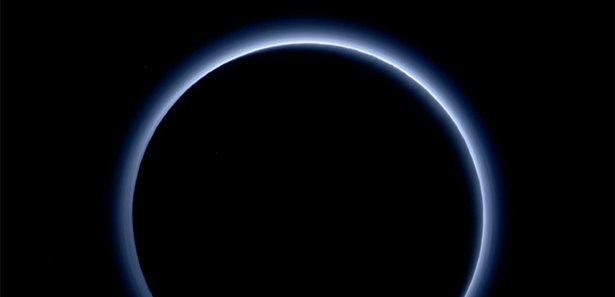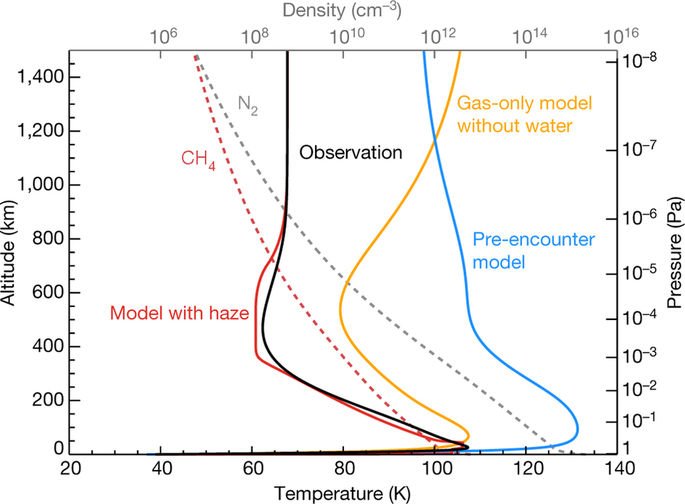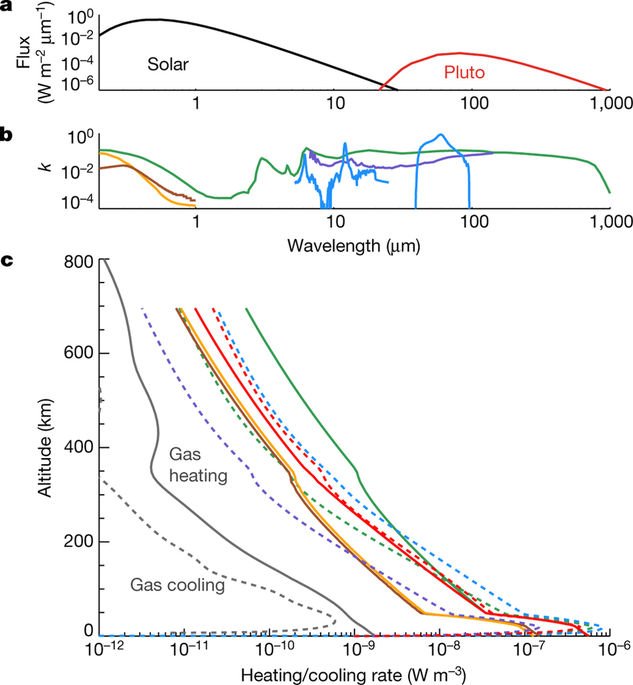Haze particles cool the atmosphere of the dwarf planet
Unique Cooling Effect: Data from the NASA's New Horizons probe provides researchers with a possible explanation for Pluto's unusually cold atmosphere. Particles in the atmospheric vapors seem to provide a unique cooling effect by releasing heat into space in the form of infrared radiation.

Image of the atmospheric veil of Pluto by the probe New Horizons. © NASA / JHUAPL / SwRIPeople used to think Pluto was a distant, dead ice world. Recently, however, the planet has turned out to be more a dynamic celestial body with bizarre landscapes and possibly active ice volcanoes. Likewise, the dwarf planet has an unusually extensive atmosphere and a blue sky. Similar to the earth.
In 2015, measurements of Pluto's atmosphere were taken for the first time by NASA's New Horizons, and it was found to be about 30 degrees Celsius colder than expected. This was a problem insofar as the gas compositions of a planet's atmosphere usually determine how much heat the planet can hold. Apparently not with Pluto: In that sense, the actual measurements did not match the predictions of the scientists at all.
Cooling effect by haze particles

Atmospheric temperature and gas-density profiles of Pluto. © University of California - Santa Cruz
A possible explanation has now been found by scientists led by Xi Zhang of the University of California at Santa Cruz. Their analysis shows that particles in the haze - a result of chemical reactions in the atmosphere - provide a unique cooling effect.
The ultraviolet radiation of the sun ionizes with nitrogen and methane, whereby hydrocarbon particles form, which sink down and thereby generate ever larger aggregates. Using model simulations, scientists have now been able to show how this phenomenon could affect the temperature of the atmosphere.
Heat loss in the form of infrared

Radiative heating and cooling in the atmosphere of Pluto. © University of California - Santa
The result: Compared to the gas molecules, the haze particles absorb more sunlight, which would actually heat up the atmosphere. However, the models of Zhang's team show that the hydrocarbon particles emit much more heat, in the form of infrared radiation, into space.
This results in a cold atmosphere about minus 203 degrees Celsius and not just minus 173, as originally thought.
Pluto is the first known planetary celestial body in our solar system, where the energy balance of the atmosphere is primarily regulated by solids in the form of vapor particles rather than gases, Zhang says.
"Not verifiable"
Even though the model calculations are surprisingly consistent with the measured temperature profile, there's a snag to it. According to Rober West of the California Institute of Technology in Pasadena, the calculated heating and cooling rates are associated with great uncertainties.
We do not know how exactly the haze over Pluto is composed.
West emphasizes that the researchers have adopted a particle composition that behaves in their model so that it can explain the observation. Whether this corresponds to reality, could not yet be verified.
New telescope could bring clarity
NASA's new James Webb Space Telescope is scheduled to begin service by the end of 2018 and could show whether Zhang's team is right. If the scientists' models are correct, the cooling effect would have to produce detectable infrared emissions, which would confirm the theory.
Unfortunately, today's instruments are too weak to make those measurements.
The James Webb Space Telescope should be sensitive enough to either back up or disprove the model, says West.
If the researchers' hypothesis is confirmed, this could be helpful for the future exploration of hazy atmosphere exoplanets.
Source: Nature, 2017 doi:10.1038

Interesting information how was the pics of Pluto taken sometimes i really wonder
Hi @princeshady5 : I am quite sure that picture was taken by NASA's New Horizons flyby in the year 2015.
Look at this amazing pictures:
https://solarsystem.nasa.gov/planets/pluto/galleries
It was taken by the probe New Horizons just after it passed Pluto (with the sun behind Pluto seen from the probe).
wow great information you had gather today ... i was never know these fats if you had not share it .. i feel so amazing when i get to see your post ☺
Thank you!
welcome ☺
Pluto really fascinates me, nearly as much as Titan. I think the action of UV radiation on methane in presence of nitrogen creates Tholins, a class of compounds which contain a wide array of organic molecules. These are probably the compounds mentioned in the article.
Did you know that because these molecules are under the form of an aerosol, in suspension in the atmosphere, they diffuse light as the molecules in the air do on Earth? In other word, the sky seen from Pluto would be like that of Earth on a Sunny day: Blue.
You can actually see it if you look closely at the haze on the pic: It’s blue.
Hi @murphy, you are right, besides Pluto being fascinating, the source of my article itself references to a document about Tholins.
More precisely, they seem to have created a simulated Titan-like environment:
http://www.sciencedirect.com/science/article/pii/0019103584901428?via%3Dihub
Sounds interesting.
And yes again :-), you are absolutely right the sky of Pluto seems to be very similar to the one of the Earth. I mentioned that in the article.
Thank you for the informative reply!
Nice to update the knowledge and yes won't forget my jacket on the Trip to Pluto this Christmas !!!
Yes, you should definitely wear a warm one ;-)
I mean Fashion Jacket hehe
img credz: pixabay.com
Nice, you got a 93.0% @bestofeverything upgoat, thanks to @n3bul4
It consists of $4.85 vote and $0.72 curation
Want a boost? Minnowbooster's got your back!
The @OriginalWorks bot has determined this post by @n3bul4 to be original material and upvoted(1.5%) it!
To call @OriginalWorks, simply reply to any post with @originalworks or !originalworks in your message!
excellent information in this here.that pluto is colder than other,
Congratulations! This post has been upvoted from the communal account, @minnowsupport, by n3bul4 from the Minnow Support Project. It's a witness project run by aggroed, ausbitbank, teamsteem, theprophet0, someguy123, neoxian, followbtcnews/crimsonclad, and netuoso. The goal is to help Steemit grow by supporting Minnows and creating a social network. Please find us in the Peace, Abundance, and Liberty Network (PALnet) Discord Channel. It's a completely public and open space to all members of the Steemit community who voluntarily choose to be there.
This wonderful post has received a bellyrub 11.44 % upvote from @bellyrub. Please make sure to vote for my pops as a witness @zeartul,Here